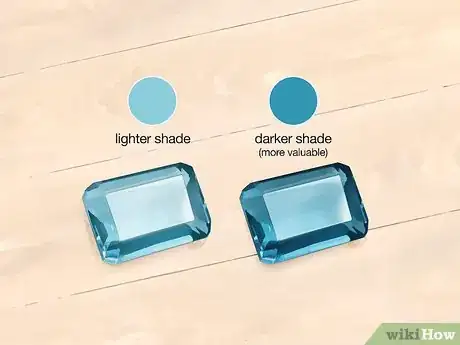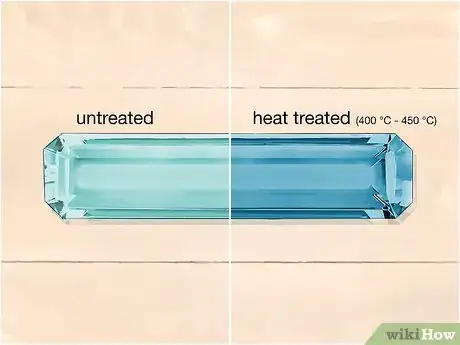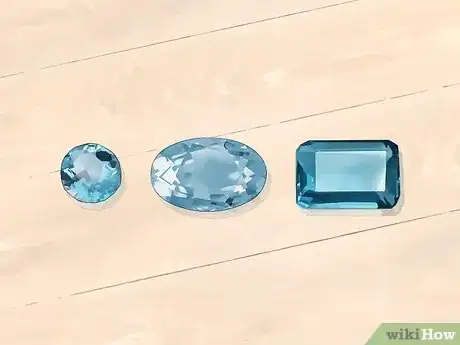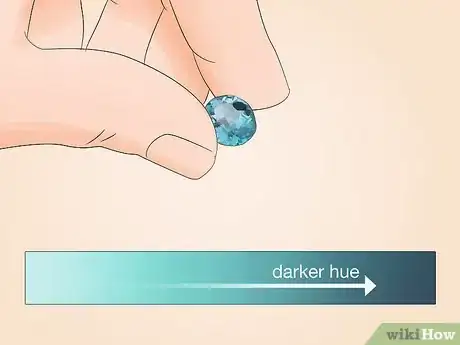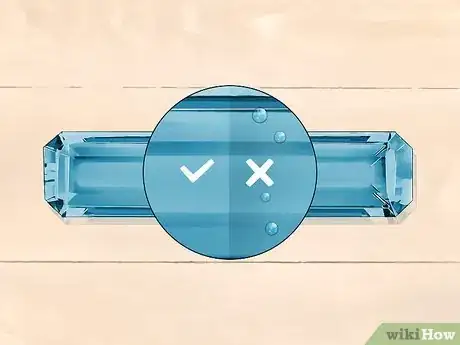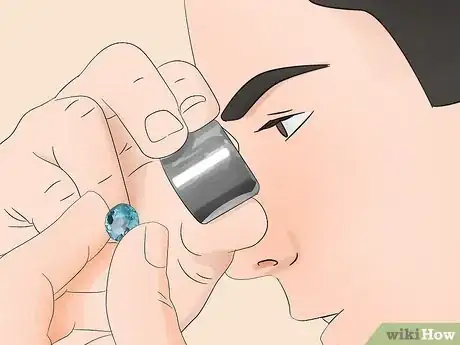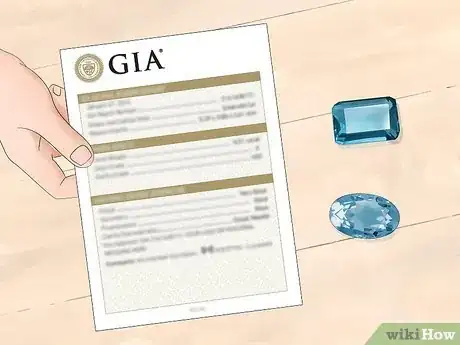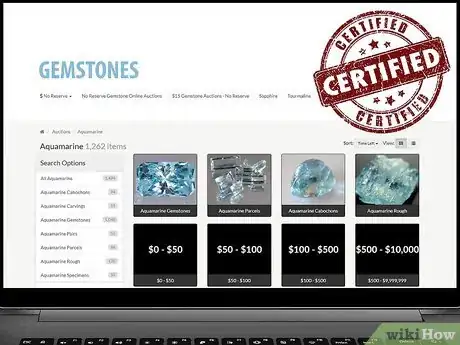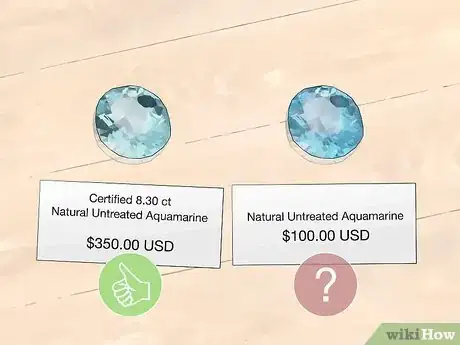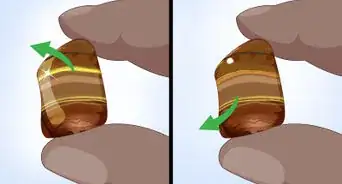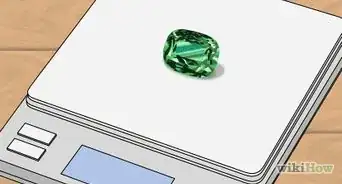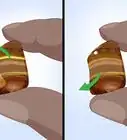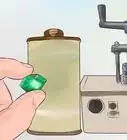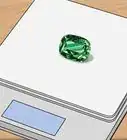This article was co-authored by Alisa Thorp and by wikiHow staff writer, Hannah Madden. Alisa Thorp is a Jewelry Design & Ethical Gemstone Expert and the Co-Founder of Mercurius Jewelry. With over 15 years of experience, she specializes in responsibly-sourced fine jewelry. She holds a BS in Environmental Science from Columbia University and is studying gemology at the Gemological Institute of America (GIA).
There are 11 references cited in this article, which can be found at the bottom of the page.
wikiHow marks an article as reader-approved once it receives enough positive feedback. In this case, 100% of readers who voted found the article helpful, earning it our reader-approved status.
This article has been viewed 264,515 times.
Aquamarine is a popular and affordable gemstone. It is a member of the beryl family, and gets its blue tint from traces of iron in chemical composition.[1] Unlike its cousin, the emerald, this beryl-based stone is highly resistant to inclusions and relatively easy to mine, making it fairly common and much less expensive. If you want to buy aquamarine gemstones, you should learn how to spot a high quality stone and shop smart by setting a budget and avoiding untrustworthy sellers.
Steps
Identifying the Characteristics You Want
-
1Pick your desired gemstone shade. Deep sky blue stones are the most valuable and, in general, darker shades are more coveted than lighter shades. Choosing an intensity is mostly a matter of personal preference.[2]
-
2Consider a heat-treated aquamarine for a more blue color. Heat treatment is a widely accepted practice used to enhance the blueness of a stone. Yellow-brown and yellow-green stones are heated to a temperature between 400 °C (752 °F) and 450 °C (842 °F) degrees and then cooled.[3]
- This treatment is permanent and enhances the blueness of the stone without damaging it.
- Many aquamarine stones are more of a “sea-foam” color than a true blue color before they are heated.
- Heated aquamarines with a strong blue-green hue cost around $180 per carat.
Advertisement -
3Determine the carat weight that you want. Large aquamarine gemstones are readily available and can be found easily up to 25 carats. Smaller aquamarine gemstones are usually darker in shade, and you will be able to find a higher quality stone at a lower price.[4]
- Small aquamarines look nice in delicate pieces, but large aquamarines can make a striking statement.
- Since aquamarine is fairly common, you can usually find large carat stones for affordable prices. For most gemstones, the price per carat rises considerably with more carats, but the price per carat for a 30 carat aquamarine is only ⅓ percent higher than the price per carat of a 1 carat aquamarine.
-
4Decide what shape you want your aquamarine to be cut in. If you want to place your aquamarine into a piece of jewelry, find a gemstone cut into a typical emerald or oval cut. These cuts are usually a higher quality, since they expose more of the gemstone. If you want to display your aquamarine, you can find pieces that are cut into artistic or abstract shapes.[5]
Tip: Aquamarine can be cut into almost any shape, because cutting it maximizes its color.
Looking for Quality
-
1Buy a rich, dark hue for a higher quality stone. Aquamarine comes in a variety of colors, from green to blue to gray. Gemstones that have a rich, blue color are typically more valuable than green hues, but most blue-green hues are more valuable than borderline-clear stones. Ultimately, however, the right hue is a matter of personal preference.[6]
- No matter which color you are buying, look for an even color distribution throughout the gemstone.
- The most expensive unheated stones are medium to strong sky blue, and they can cost up to $600 per carat.
-
2Look for stones with no visible inclusions, or bubbles/marks. By nature, aquamarine is one of the cleanest gemstones available. Major inclusions are rare and often a sign of mistreatment. A quality aquamarine should not have inclusions that are visible to the naked eye, and any inclusions that are visible through magnification should be slight and interior.[7]
- It is becoming fashionable lately to wear aquamarine jewelry that has inclusions in the stones. You can purchase aquamarine with inclusions for a lesser price.
- Low quality to mid-range aquamarines can range from $5 to $100 per carat.
- Past 10 carats, mid-range aquamarines can cost between $150 and $200 per carat.
- High quality aquamarines are much more expensive. An unheated light blue stone can cost you around $90 per carat, while a light blue-green stone can cost you anywhere between $180 to $240 per carat.
-
3Use a jeweler’s loupe to detect blue topaz. Blue topaz is considerably less valuable than aquamarine, but the two stones can look very similar. The only way to tell them apart is by using a jeweler’s loupe and looking for 2 refraction lights, which is an indicator of blue topaz.[8]
- Avoid gemstones labeled as "Brazilian Aquamarine" or "Nerchinsk Aquamarine," since both of these actually refer to blue topaz.
- Also avoid "Siam Aquamarine," which is actually blue zircon.
-
4Avoid synthetic stones by double-checking with your seller. Since natural aquamarines are prevalent and easy to mine, they often prove less costly than synthetic aquamarines. The person who sells you your aquamarine gemstone will tell you whether or not the stone is synthetic.[9]
Making a Purchase
-
1Make sure your jeweler is certified. Ask for official certification from a nationally recognized gemological organization, such as the Gemological Institute of America (GIA). National jeweler chains are a good place to start, as they want to keep up their reputation as reputable sellers. If you want a less expensive option, look at the selection offered by local jewelers and individual sellers.[10]
Tip: Ask your jeweler for a certification of authenticity for your gemstone before you purchase it.
-
2Shop in a store rather than online whenever possible. It is much easier to scam someone over the internet. Whenever it is possible, search for a reputable jeweler in your area that has a physical storefront that you can visit.[11]
- You can visit a few stores before making a purchase to see if you are getting the best deal.
-
3Buy gemstones from reputable online jewelers. If you’d rather shop online, you can buy aquamarine gemstones from jewelers that are certified. Try to find online stores that will include a warranty and certificate of authentication with your gemstone. Be wary of sellers who are random individuals with no certifications.[12]
- The color of the aquamarine can show up as more vibrant in photographs than in person.
-
4Evaluate the price closely to make sure you aren’t being scammed. If a price for a gemstone sounds too good to be true, look at where the gemstone is coming from and ask yourself if the seller can be trusted.[13]
- Be wary of online retailers, since they can put up fake advertisements or embellish their ads with little repercussions.
Community Q&A
Did you know you can get answers researched by wikiHow Staff?
Unlock staff-researched answers by supporting wikiHow
-
QuestionWhere do you find out how much one costs?
 wikiHow Staff EditorThis answer was written by one of our trained team of researchers who validated it for accuracy and comprehensiveness.
wikiHow Staff EditorThis answer was written by one of our trained team of researchers who validated it for accuracy and comprehensiveness.
Staff Answer wikiHow Staff EditorStaff Answer
wikiHow Staff EditorStaff Answer -
QuestionHow do you tell if an aquamarine stone is real?
 wikiHow Staff EditorThis answer was written by one of our trained team of researchers who validated it for accuracy and comprehensiveness.
wikiHow Staff EditorThis answer was written by one of our trained team of researchers who validated it for accuracy and comprehensiveness.
Staff Answer wikiHow Staff EditorStaff AnswerAquamarines are hard stones that don’t scratch easily, so use a jeweler’s loupe or magnifying glass to check the surface for scratches. If you notice scratches or bubbles, the stone is likely glass. A real aquamarine should also appear to be different colors depending on the angle from which you look at the stone. Finally, place the stone against your skin to see if it feels cool, which is a sign that it’s real. Glass tends to warm up to room temperature.
wikiHow Staff EditorStaff AnswerAquamarines are hard stones that don’t scratch easily, so use a jeweler’s loupe or magnifying glass to check the surface for scratches. If you notice scratches or bubbles, the stone is likely glass. A real aquamarine should also appear to be different colors depending on the angle from which you look at the stone. Finally, place the stone against your skin to see if it feels cool, which is a sign that it’s real. Glass tends to warm up to room temperature. -
QuestionWhat color of aquamarine is the most valuable?
 wikiHow Staff EditorThis answer was written by one of our trained team of researchers who validated it for accuracy and comprehensiveness.
wikiHow Staff EditorThis answer was written by one of our trained team of researchers who validated it for accuracy and comprehensiveness.
Staff Answer wikiHow Staff EditorStaff Answer
wikiHow Staff EditorStaff Answer
Warnings
- Never try to heat-treat aquamarine yourself. You could permanently damage the stone.⧼thumbs_response⧽
Expert Interview

Thanks for reading our article! If you'd like to learn more about identifying gemstones, check out our in-depth interview with Alisa Thorp.
References
- ↑ https://www.gemsociety.org/article/aquamarine-jewelry-and-gemstone-information/
- ↑ https://www.gia.edu/aquamarine-quality-factor
- ↑ https://www.gemsociety.org/article/just-ask-jeff-what-is-the-true-color-of-aquamarine-how-is-it-heated/
- ↑ https://www.gemsociety.org/article/aquamarine-jewelry-and-gemstone-information/
- ↑ https://4cs.gia.edu/en-us/blog/aquamarine-buying-guide/
- ↑ https://4cs.gia.edu/en-us/blog/aquamarine-buying-guide/
- ↑ https://www.gia.edu/aquamarine
- ↑ http://www.differencebetween.net/object/difference-between-aquamarine-and-topaz/
- ↑ https://www.gia.edu/gem-imitation
- ↑ https://www.gemsociety.org/article/aquamarine-buying-guide/
- ↑ http://www.jewelrywise.com/engagement-wedding/article/top-10-jeweler-questions
- ↑ https://forums.gemsociety.org/t/buying-gemstones-online-safe-or-unsafe/2106/2
- ↑ https://www.gia.edu/aquamarine-quality-factor
- ↑ https://4cs.gia.edu/en-us/blog/wedding-anniversary-gemstone-list-years-11-through-20/
About This Article
To buy an aquamarine gemstone, look for a flawless stone with no marks, which looks nicer. Avoid gemstones called “Brazilian Aquamarine,” or “Nerchinsk Aquamarine,” since these are actually blue topaz stones that are often sold as imitations. Look for a high-quality cut that’s highly reflective in the light. Darker shades of blue are generally more valuable than lighter ones, but find a shade that you like. Many people prefer silver and gold metals paired with aquamarine stones, but find a metal that complements it well. For more tips, including how to assess the value of an aquamarine stone, read on!
